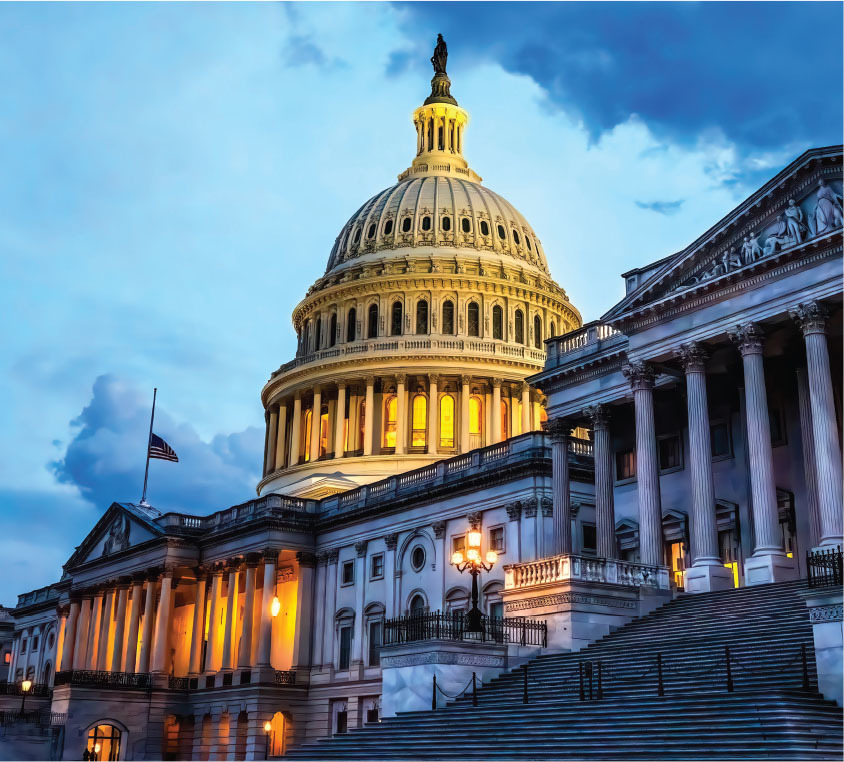December 2013
NSPE TODAY: POLICY PERSPECTIVES
Where Does Congress Go From Here?
BY ARIELLE EISER
On the morning of October 17, the federal government reopened after the first partial shutdown in nearly two decades shuttered all nonessential operations. To many, this episode of congressional dysfunction, while frustrating, seemed far removed and unrelated to their work and daily lives. However, it is critically important to remember that the decisions Congress makes, or fails to make, can have wide-ranging implications for engineers.
During the shutdown, transportation, infrastructure, and contracting opportunities spanning many industries were brought to a grinding halt. Another federal government shutdown or further reductions in annual appropriations would have an even greater long-term impact on the engineering community. Therefore, engineers need to consider the next steps Congress must take as it sets out yet again to solve the nation’s budget woes.
After a grueling 16-day shutdown, the Senate and House approved a continuing resolution to temporarily fund the federal government through January 15, 2014. This gives Congress a bit of breathing room, but not much. The CR funds the government for 90 days at almost the same rate as Fiscal Year 2013, after automatic spending cuts and a handful of adjustments. The funding measure provides annual discretionary funding at a rate of $986.3 billion. The CR included several additional provisions that were included in previous Senate and House versions, including an increase to $2.9 billion for a water navigation project within the lower Ohio River in Illinois and Kentucky.
One of the most important components of the budget discussions moving forward is not codified in the current continuing resolution. As part of the deal reached by Senate leaders, but not specifically included in the CR, a budget conference committee was appointed to reconcile the Senate and House’s disparate FY 2014 budgets. The conference committee is led by Senate Budget Chairwoman Patty Murray (D-WA) and House Budget Chairman Paul Ryan (R-WI). The conference committee must submit a spending plan to both chambers of Congress by December 13. Although there are no immediate consequences if the committee is unable to come up with a compromise bill, if no progress is reached before the CR expires, Congress will once again be faced with an imminent government shutdown.
Unlike the “super committee” set up by the Budget Control Act in 2011, which failed to yield a grand bargain and resulted in sequestration, this budget conference committee is tasked only with setting appropriations for FY 2014. As Chairman Ryan stated, “This is the budget process.… This is how the founders envisioned the budget process. We want to get back to that. We haven’t had a budget conference since 2009 and we think it’s high time we start talking together trying to reconcile our differences.”
Even Ryan and Murray conceded at the outset that passing a conference bill will be very difficult. The House and Senate each passed their own budget resolutions back in March. However, they never convened a conference committee until this point due, in large part, to the markedly different caps set by the two chambers. The Senate budget resolution approved a $1.058 trillion discretionary budget, while the House budget resolution approved a $967 billion discretionary budget.
These two budgets represent fundamentally different priorities and approaches. A return to regular order in the budgeting process is a most welcome development and presents an important opportunity to replace sequestration with a more thoughtful approach to budget reductions. If Congress can enact a full-year appropriations bill, the paralysis that has virtually halted legislative activity can finally yield to a more productive Congress. However, compromise will be necessary and, given recent history, that remains unlikely.
Whether or not Congress resolves this latest budget crisis by January 15, there are several engineering priorities that await. One of the few truly bipartisan bright spots is the new authorization for the U.S. Army Corps of Engineers. In May, the Senate passed the Water Resources Development Act by a vote of 83-14. The House companion legislation, the Water Resources Reform and Development Act, was approved by a vote of 417-3 on October 23. The legislation’s sponsors believe that a conference committee to reconcile the differences between the two bills can complete final legislation to be enacted into law by early 2014. This authorization, the first for the Corps in six years, would streamline the infrastructure project delivery process and strengthen our nation’s water transportation networks.
Congress will also need to enact a new surface transportation reauthorization bill. The current authorization will expire in late 2014. The House and Senate are already considering new alternatives to improve our national infrastructure, and this will be an important year for coming up with long-term solutions.
Whatever happens, it’s time for Congress to move forward.
Arielle Eiser is NSPE’s government relations manager.
How Did the Federal Government Shutdown Affect You?
If your work as a professional engineer was affected by the federal government shutdown, please e-mail your story to [email protected].


 Volunteering at NSPE is a great opportunity to grow your professional network and connect with other leaders in the field.
Volunteering at NSPE is a great opportunity to grow your professional network and connect with other leaders in the field. The National Society of Professional Engineers (NSPE) encourages you to explore the resources to cast your vote on election day:
The National Society of Professional Engineers (NSPE) encourages you to explore the resources to cast your vote on election day:



